You can listen to Hoosier History Live! live on the air each Saturday, or listen online at the WICR website during the broadcast on any computer with speakers, anywhere, or on a smartphone. We invite you to visit our website!
Jan. 21 show
Dan Wakefield on '50s landmarks in Indianapolis
First and foremost, he's probably known for his best-selling novel Going All the Way (1970), which was set in Indianapolis during the 1950s.
But Dan Wakefield also wrote an acclaimed memoir called Returning: A Spiritual Journey (1988), and returning is what the celebrated author-journalist-screenwriter-educator has just done. 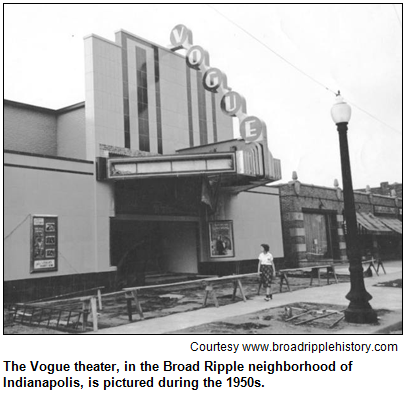 He recently moved back to his hometown (Wakefield, 79, grew up on the northside of Indy and graduated from Shortridge High School in 1950) after decades spent living in Miami, New York City and Boston.
He recently moved back to his hometown (Wakefield, 79, grew up on the northside of Indy and graduated from Shortridge High School in 1950) after decades spent living in Miami, New York City and Boston.
So Dan will join Nelson in studio to share insights on a range of topics. Ours being a history show, we can't resist having him reflect on local landmarks that not only figure in his early life; many have been featured in his books, particularly Going All the Way, which inspired a 1997 movie filmed in Indy.
The landmarks - some bygone, some very much still with us - include the Red Key Tavern; the Tee Pee and the Ron-D-Vu (beloved eateries that were the focus of a recent Hoosier History Live! show about drive-ins); the Mandarin Inn (in Dan's recollection, one of the few ethnic restaurants in the city during his boyhood years); Crown Hill Cemetery, and, of course, Shortridge.
During his high school days, Dan was co-sports editor of The Echo, the daily newspaper at Shortridge, sharing duties with Richard Lugar, the future mayor and U.S. senator.
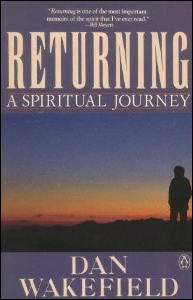 Dan's current project involves another illustrious Shortridge grad. He's assembling and editing a collection of letters from his late friend, literary icon Kurt Vonnegut Jr., a member of Shortridge's Class of 1940.
Dan's current project involves another illustrious Shortridge grad. He's assembling and editing a collection of letters from his late friend, literary icon Kurt Vonnegut Jr., a member of Shortridge's Class of 1940.
So there's much hometown turf to cover with Dan, whose other books include Starting Over (1973) - it was made into a movie starring Burt Reynolds and Candice Bergen - and Expect a Miracle (1995).
Since Dan's return to his hometown just before the holiday season, he's been living in an apartment in downtown Indy. For 17 years previously, he lived in the Miami area and taught at Florida International University. He's no stranger to audiences across the country, though. Thanks to his books such as Creating from the Spirit (1996) and How Do We Know When It's God? (1999), he has led workshops on creativity and spirituality in many cities.
For Hoosier History Live!, though, we will have our distinguished guest hone in on Indy-area sites that figured in his youth and, later, in his works.
The only child of a pharmacist and a housewife, Dan Wakefield grew up in Broad Ripple. He attended School 80 at 920 E. 62nd Street (it's now condos), was an active Boy Scout and found himself enthralled by movies at The Vogue, which today is a popular nightspot/concert venue since a series of renovations that began more than 30 years ago.
 Sports-crazed as a boy, Dan once told Nelson - who features him in his book Indiana Legends: Famous Hoosiers from Johnny Appleseed to David Letterman, 4th Edition (2005) - that his goal was to grow up and coach football at the University of Notre Dame. Almost instantly cut from Broad Ripple High School's football team (in Returning, Dan describes himself as "small," "skinny," "bumbling" and "uncoordinated"), he transferred to Shortridge and thrived at The Echo.
Sports-crazed as a boy, Dan once told Nelson - who features him in his book Indiana Legends: Famous Hoosiers from Johnny Appleseed to David Letterman, 4th Edition (2005) - that his goal was to grow up and coach football at the University of Notre Dame. Almost instantly cut from Broad Ripple High School's football team (in Returning, Dan describes himself as "small," "skinny," "bumbling" and "uncoordinated"), he transferred to Shortridge and thrived at The Echo.
In Going All the Way, the alma mater of the central characters is called "Shortley," although the student newspaper is referred to as The Echo. Another character is a former waitress at the Ron-D-Vu. Referring in Returning to the drive-in's appeal for his pack of teenage friends, Dan writes:
"We giggled and punched and sang and screamed and piled into one another's jalopies, circling the drive-ins like sharks before nosing into a slot at the Ron-D-Vu for french-fried onion rings and a chance to talk to the fabulous girls who ran in their own herds."
In Going All the Way, which is set several years after the protagonists have graduated from high school, one character invites another to look at his artwork in the mid-afternoon of a summer day at the Red Key Tavern on North College Avenue.
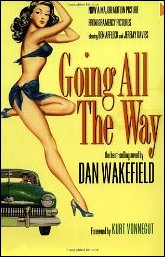 "That seemed a funny place to look at a painting, a bar that was dark even in the brightest part of the day," Dan writes. Even so, the characters are clearly fond of the Red Key, which they often just call "The Key." (With its jukebox and vintage atmosphere, the tavern remains a popular hangout today, more than 60 years after it opened.)
"That seemed a funny place to look at a painting, a bar that was dark even in the brightest part of the day," Dan writes. Even so, the characters are clearly fond of the Red Key, which they often just call "The Key." (With its jukebox and vintage atmosphere, the tavern remains a popular hangout today, more than 60 years after it opened.)
Crown Hill, the third-largest private (non-military) cemetery in the country, also remains as much of an Indy landmark as it was during Dan Wakefield's boyhood. Sprawling over 550 acres, Crown Hill has a three-arched Gothic gateway at Boulevard Place and 34th Street and is the burial site of more American vice presidents (three) than any other cemetery. Crown Hill also is the burial site of gangster John Dillinger, President Benjamin Harrison, poets, tycoons and generations of Vonneguts, although not of Kurt Jr., who died in 2007.
Dan Wakefield credits Vonnegut with helping draw the attention of publishers and critics to Going All the Way, which Dan set in Indy after initially considering Cleveland and other cities.
"Placing it in Indianapolis gave the book an emotional center," Dan once told Nelson. "I care about Indianapolis. I really don’t care about Cleveland."
History Mystery
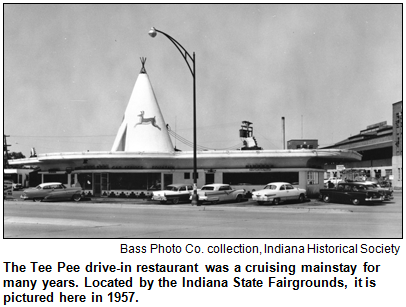 During a recent Hoosier History Live! show about drive-in restaurants, our focus included the beloved Tee Pee. The History Mystery inquired about the best-selling book that featured several mentions of the Ron-D-Vu; the answer was Going All the Way.
During a recent Hoosier History Live! show about drive-in restaurants, our focus included the beloved Tee Pee. The History Mystery inquired about the best-selling book that featured several mentions of the Ron-D-Vu; the answer was Going All the Way.
Among other drive-ins discussed during the show was a bygone restaurant on the westside of Indianapolis. Popular during the 1950s and '60s, the drive-in was located near West 16th Street and Lafayette Road.
Question: Name the drive-in restaurant.
To win the prize, you must call in with the correct answer during the live show. Please do not call if you have won a prize from any WICR show during the last two months. The call-in number is (317) 788-3314, and please do not call until you hear Nelson pose the question on the air.
The prize is a gift certificate to the Jameson Inn on the Westside of Indianapolis, as well as two tickets to the Indianapolis Motor Speedway Hall of Fame Museum. These prizes are courtesy of the ICVA.
Roadtrip: Super art
 Roadtripper Chris Gahl of the ICVA tells us that "super local art," hand-made by artists right here in the "super city," can be seen now at the majestic old Indiana State Museum building downtown at 202 N. Alabama Street.
Roadtripper Chris Gahl of the ICVA tells us that "super local art," hand-made by artists right here in the "super city," can be seen now at the majestic old Indiana State Museum building downtown at 202 N. Alabama Street.
In an exhibit called TURF, the IDADA-inspired art showcase is inviting throngs of visiting Super Bowl fans to indulge in Indy's art scene. The exhibit also is intended to be a sort of gateway for visitors who might later want to explore the Massachusetts Avenue gallery and restaurant scene.
More than 1,000 Indianapolis Public Schools students will be taking a tour of TURF. The exhibit is free and open to the public Tuesday through Sunday from 10 a.m. to 7 p.m., right up to that fateful game day of Feb. 5.
RSVP today!
Feb. 16 is our fourth-anniversary party
Can you believe it? Hoosier History Live! has been on the air for four years! We are proud to have become a unique asset to the state of Indiana, producing original content every week that is then added to our growing online archive. Thanks to all who have listened, clicked, browsed and supported the show!
 We plan to be around quite awhile longer, contributing to Indiana's culture and offering a well-reported take on our state's rich and varied history.
We plan to be around quite awhile longer, contributing to Indiana's culture and offering a well-reported take on our state's rich and varied history.
Come join in the festivities as we celebrate four years on the air at the Morris-Butler House, 1204 N. Park Ave. in Indianapolis, on Thursday, Feb. 16 from 5 to 8 p.m.
Wine, soft drinks and appetizers will be served. Generously hosted by Indiana Landmarks, this is a free event; however, checks (payable to Indiana Humanities, with a memo line "for Hoosier History Live!") are graciously accepted!
You can click here to RSVP, or send an email to molly@hoosierhistorylive.org.
Your Hoosier History Live! team,
Nelson Price, host and creative director
Molly Head, producer, (317) 927-9101
Chris Gahl, Roadtripper
Richard Sullivan, webmaster and tech director
Pam Fraizer, graphic designer
Garry Chilluffo, creative consultant
Michele Goodrich, Jed Duvall, grant consultants
Joan Hostetler, photo historian
Dana Waddell, volunteer-at-large
www.hoosierhistorylive.org

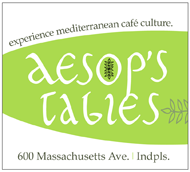



Please tell our sponsors that you appreciate their support: Aesop's Tables, Indiana Historical Society, Indiana Landmarks, Lucas Oil and Story Inn.
 Acknowledgments to Print Resources, Indianapolis Marion County Public Library, Monomedia, Indiana Humanities, Indianapolis Convention & Visitors Association, WICR-FM, Fraizer Designs, Heritage Photo and Research Services, Derrick Lowhorn, Samantha Stratton and many other individuals and organizations. We are an independently produced program and are self-supporting through organizational sponsorships, grants and through individual tax-deductible contributions through the Indiana Humanities Council. Visit our website to learn how you can support us financially.
Acknowledgments to Print Resources, Indianapolis Marion County Public Library, Monomedia, Indiana Humanities, Indianapolis Convention & Visitors Association, WICR-FM, Fraizer Designs, Heritage Photo and Research Services, Derrick Lowhorn, Samantha Stratton and many other individuals and organizations. We are an independently produced program and are self-supporting through organizational sponsorships, grants and through individual tax-deductible contributions through the Indiana Humanities Council. Visit our website to learn how you can support us financially.
Jan. 28 show
Rev. Jim Jones and Indiana connections
In the final portion of his life, Rev. Jim Jones was associated with Guyana, where more than 900 of his followers participated in a mass murder-suicide in 1978, and California, where his transplanted church, which he called the Peoples Temple, was based for several years.  The notorious spiritual leader, though, began life and launched his church in Indiana.
The notorious spiritual leader, though, began life and launched his church in Indiana.
To explore and explain Jones' links to Indiana, Rachael Heger of the Indiana State Library will join Nelson in studio. Rachael, the Indiana division supervisor at the state library, has researched and gives presentations about the Hoosier chapters in the life of Jim Jones, who was born in the town of Lynn in far-eastern Indiana in 1931.
A graduate of Richmond High School, Jones attended Butler and Indiana universities before moving to Indianapolis in the 1950s. As Rachael notes in her talks, he sold monkeys to help finance his church, which had various locations. (They included a building at 10th and Delaware streets and, before that, at 15th and New Jersey.)
While living in Indiana, Jim Jones and his wife adopted several children of various races. "He called this his 'Rainbow Family,'" Rachael notes.
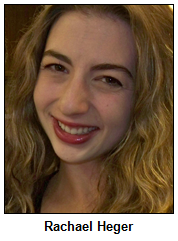 He started soup kitchens, took pride in the racial diversity of his congregations and was appointed in 1961 by then-Mayor Charles Boswell to the Indianapolis Human Rights Commission.
He started soup kitchens, took pride in the racial diversity of his congregations and was appointed in 1961 by then-Mayor Charles Boswell to the Indianapolis Human Rights Commission.
Amid increasing local skepticism as he characterized himself as a "prophet," Jones left Indiana in 1965 and urged hundreds of his followers to resettle in California with him.
According to the Encyclopedia of Indianapolis, his Indianapolis years were both praised (for his social work) and criticized because some people began to regard him as "an unbalanced, power-hungry fanatic."
Rachael's presentations about his Hoosier years are part of a series in which she and others at the state library respond to frequently asked questions from the public.
© 2012 Hoosier History Live! All rights reserved.